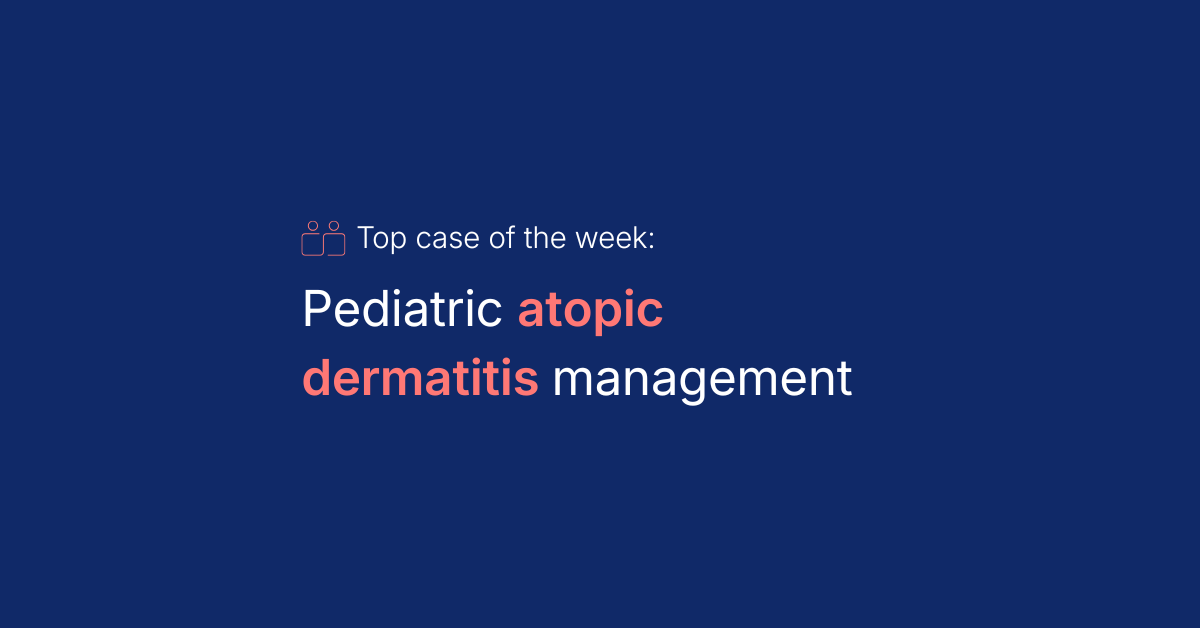
Next steps for pediatric atopic dermatitis treatment

Atopic dermatitis (AD) is a common chronic skin condition in children, often causing persistent itch, dryness, and disrupted sleep.
This case highlights a young girl with a history of AD since age 2, who continues to experience flares despite regular use of emollients and low-potency topical corticosteroids. Concerned about steroid overuse and long-term safety, her parents are working with the practitioner to seek effective, non-steroidal treatment options.
What non-steroidal treatment for this case of atopic dermatitis would you recommend? Log in or sign up to leave a comment and see the Consensus.
Post:
A 7-year-old female with a history of atopic dermatitis since age 2 presents with persistent dry, itchy patches on the face, wrists, and behind the knees. Her parents report frequent nighttime scratching leading to sleep disruption.
She has been managed with emollients and low-potency topical corticosteroids but continues to experience recurrent flares. They are concerned about steroid overuse and long-term safety, and ask about alternative treatment options.



 Questions
Questions
 Comments
Comments
Key takeaways on next steps for atopic dermatitis treatment:
- Non-steroidal options can effectively manage pediatric AD
Topical calcineurin inhibitors (tacrolimus, pimecrolimus), PDE4 inhibitors (crisaborole), and JAK inhibitors (ruxolitinib) offer safe, steroid-free control. - Confirm adherence before escalating treatment
Frequent flares often stem from inconsistent moisturizing or topical use—reinforce daily routines and proper application first. - Refer when symptoms persist or worsen
Escalate care if multiple trials fail, flares are frequent, or infection and sleep disruption become issues.
Pediatrics
"1. Topical PDE4 inhibitors and calcineurin inhibitors are both good choices for her age group if the parents want to use non-steroidal medications.
2. I really like to make sure patients are being compliant with frequent moisturizing, using hypoallergenic products, and using their topical medicated product before I refer them for further treatment. Often, compliance is an issue. If she were still having regular symptoms of rash and itch despite all of these things, I would refer to dermatology."
Pediatrics
"1. If there are concerns with the effectiveness of topical steroids or the desire to avoid them altogether, I would try tacrolimus or pimecrolimus. Also, possibly crisaborole.
2. If 2-3 trials of topical therapy failed."
Dermatololgy
"1. Crisaborole, pimecrolimus, and ruxolitinib are all approved for children and would provide steroid-free control and relief, after adding a different low-potency steroid and weaning when appropriate—these are always safe as well. I would also add an oral antihistamine at night and culture for staph/strep, as these kids often have secondary infection from scratching. A tablespoon of bleach in a quick tepid bath every night helps control the incidence of secondary impetigo.
2. I am a dermatologist, so I would welcome such a case, as this is what I do!"
Dermatology
"1. Topical calcinuerin inhibitor, topical JAK inhibitor, may also consider topical PDE4 inhibitor.
2. When there are repeated flares, difficulty with the topical regimen, worsening of symptoms, and level of disease."
Dermatololgy
"1. There are multiple lubricants available for some symptomatic relief, but I prefer to use a low to mid potency topical corticosteroid and have the pharmacist compound it with a lubricating topical such as Eucerin or Aquaphor. This serves a dual purpose of adding lubrication while at the same time reducing the topical steroid concentration and dosage to a far more tolerable and safe level
2. With patients of a young age, I attempt to buy as much time as possible before escalating treatment, but considerable time has to be spent explaining this to parents who often want the strongest and most rapid-acting agents to be used."
Want to see more peer recommendations for atopic dermatitis treatment? Review the full case on Healthcasts and leave a comment to help your peers.

